- JP
- EN

GallerySeekThis is Yuka Taguchi’s first solo exhibition in about four years at
We asked him about his changing state of mind and his new work!
–What is the theme of this exhibition?
This time, we decided to divide the exhibition into two periods, with the first half being “Yoi” and the second half being “Ming”.
Just as there are mornings and evenings in a day, various events change and flow with time.
It is natural to “keep changing” in life, and even though there are various emotions in it, it itself also flows and changes.
I wanted to express the power of such “transition” itself through the exhibition.
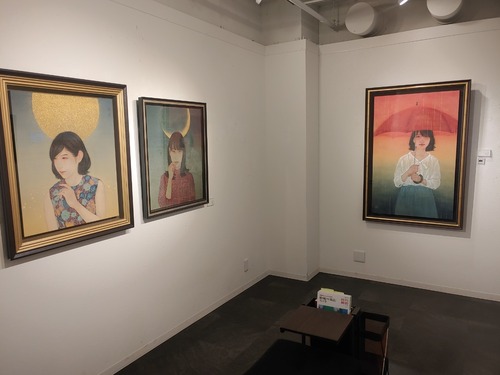
Scenery of the “Night” session in the early stage

Scenery of the “Ming” session in the early stages
–こちらのテーマに至ったのは何故でしょうか。
Actually, it was difficult to come up with an idea for the theme, but when I started drawing the 80 sketch, which was the main work for this exhibition, I also decided on the overall idea for the solo exhibition.
The coronavirus outbreak last year affected me personally, and I also included the changes in my approach to my own work in recent years, which led me to choose “Dawn” as the theme for this exhibition.
It was decided beforehand that the exhibition would be divided into two periods, so I decided to express that in the first and second periods.
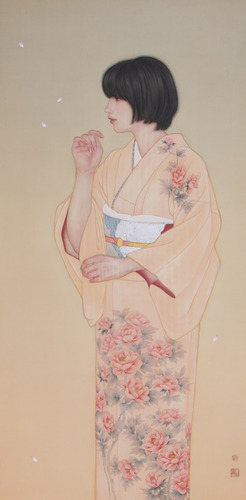
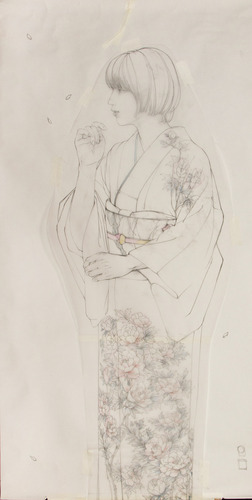
“Spring Light”1455×730mm the lower illustration
silk, mizu-hi-e paints, mineral pigments
80The work “Shunko” (Spring Light), No. 2, is the first time he painted a person in a kimono.
The kimono dressing teacher helped me to dress the model.
I had wanted to paint this kimono with pale peonies on it someday, and it finally came true.
–Have there been any changes in your work or state of mind since your last solo exhibition?
2I started to paint on Japanese paper again, in parallel with silk books, from two years ago.
This is because the warp threads of silk books shrink when they are lined, and I was particularly concerned about the change of a few millimeters when I was drawing people.
I draw my works on Japanese paper using thin Japanese paper that can be colored on the reverse side. At first it was difficult to handle because I couldn’t control the blotches, but I thought it was also interesting, so I sometimes paint on a theme that makes the most of the blotches, and sometimes I dare to leave the blotches as they are.
–The piece “Hundred Night Wednesday” from the first semester and “Evening” The work was painted on the theme of “awareness” about the diversity of ways of seeing.
Since I was an undergraduate student, I often used the “moon” in my works because it was one of the elements to express space.
More recently, I’ve been thinking about how the fact that the moon exists doesn’t change, but the way we see it changes depending on the situation and the angle we look at it. I have recently come to feel that although the fact that the moon exists does not change, the way we see it changes depending on the situation and the angle from which we look at it, and that this constant change is similar to the world and human life.
When I first thought thatI thought it was similar to plaster drawings in that the way it looks changes depending on the situation and angle“Life is a plaster drawing! I thought, “But it doesn’t actually have to be a plaster drawing or the moon, it can be applied to anything in the same time frame.
I think it was that realization that triggered it.
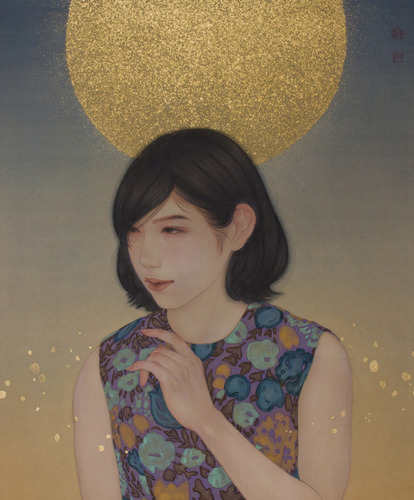
‘Midnight Wednesday’F20
Silk, water-dried paint, mineral pigments, gold leaf
–Taguchi-san, when you draw a person What do you stick to when you draw people?
When I draw a portrait, faces have expressions, so I am aware of this from the drafting stage. I am especially careful about this point from the drafting stage, because I think that things with expressions have emotions attached to them.
–How does the production process work? How does the production process work?
The first step is to make a drawing.
On the basis of the sketches, I build up an image of the work. Once the image of the work is solidified, I choose silk or Japanese paper and start to create the main painting.
In case of silk, the process begins with assembling a wooden frame according to the size of the work. The process begins with assembling the wooden frame according to the size of the work.
The left side is a “drawing” and the right side is a “sketch”.
I do “sketches” to observe, understand and record the motifs. In the case of flowers and figures, I basically have a limited time to draw, so I select and choose the necessary information as I draw.
The “rough sketch” is a drawing in which the necessary lines are transferred from the sketch, composed, and the necessary information is added. I add the necessary information to the work.
Because major revisions are not possible once the painting is complete, it is important to make final adjustments to the overall composition at the time of the drawing. I try to make final adjustments to the overall composition at the time of the drawing below.
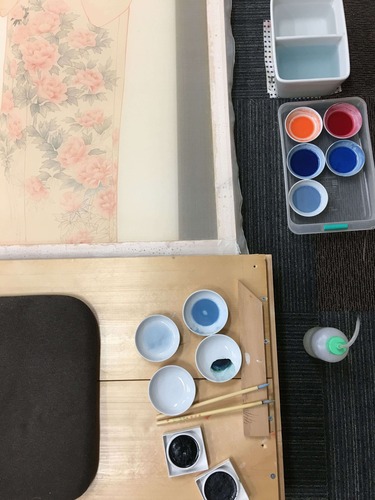
In terms of coloring, Japanese paintings are limited in the colors that can be used, so I build up my work by considering the order in which I put the mineral pigments on the screen, the size of the particles, and so on.
If the same paint is used, for example, a color applied with a single coat of dark paint and a color applied with a single coat of light paint, the colors will be different. The same paint will look different if, for example, a color is made darker by applying a single coat of dark paint and a color that is made darker by applying several coats of diluted paint.
Also, in the case of rock paints with different particle sizes, the speed of the The speed of sedimentation is different, so mixing colors can be difficult.
In such cases, the colors are matched by painting over them.
Silk, water-dried paint, rock paint
–Many of the later and “Ming” works are cherry blossom works.
Of course, cherry blossoms themselves are beautiful, but I also like the way the petals fall in the wind. I also like the way the petals fall in the wind.
I think it’s a flower with a fleeting image, but like this “fullness”, it has a new image just before it falls. It is a flower with a fleeting image, but it is also a flower that gives us a sense of the strength of life and the seasons.

“Full”4F
Japanese paper, water-dried paint, mineral pigments, gold leaf
First of all, cherry blossoms are in bloom for a short period of time, and as soon as they are in full bloom, they start to fall, so it’s difficult to find the right timing for coverage.
Also, in spring, it is windy, hot and cold. I always struggle because of the harsh environmental conditions.
There are many petals and it takes time to draw a single branch. I draw a little by little.
–What new challenges do you want to take on in the future? What are your new challenges in the future?
In addition to silk books and Japanese paper, I would like to find a suitable base material for my works. I would like to find other base materials for my works. Or in the future, I would like to make it by myself.
–Finally, please give a message to everyone who sees your solo exhibition.
Please do!
Thank you, Taguchi-san!
The solo exhibition will be open until tomorrow, Sunday, March 28.
Please take this opportunity to take a look…
Click here to read the previous interview.
→Interview with Yuka Taguchi : Gallery Seek Official Blog(livedoor.jp)
“YUKA Taguchi Solo Exhibition -Yojimei-” March 15 (Mon) – March 28 (Sun)
The first half “Evening” March 15-21
The second half “Ming” March 22 March 28
Venue: Gallery Seek Writer: Yuka Taguchi Writer’s Day. March 21(Sun) and 22(Mon) 13:00-17:00 on each day
Yuka Taguchi depicts the beauty of people, animals, and plants as they are and the breath of life by using the soft and moist texture characteristic of Japanese-style painting. Born and raised in the rich natural environment of Gifu, her sensibility is reflected in her works, which are completed through meticulous seasonal sketches. Sometimes she spends years warming up to a subject before painting it. In this solo exhibition, the exhibition will be presented as “Yoi” (evening) in the first half of the exhibition and “Akari” (light) in the second half. Just as there are morning and night in a day, various events change and flow with time. Continuous change is a natural part of life, and even if there is sadness in it, it itself also flows and changes. Through the exhibition, I express the power of such “change” itself. We hope you will enjoy the works of these young artists who are always pursuing their own unique style of Japanese painting.